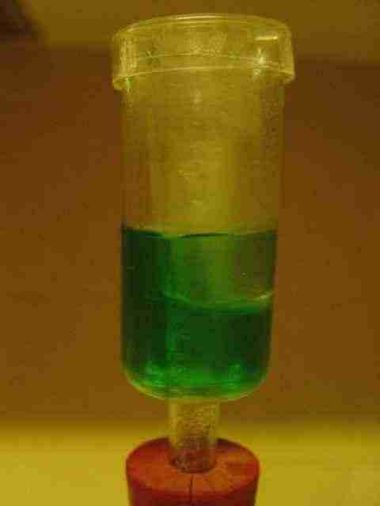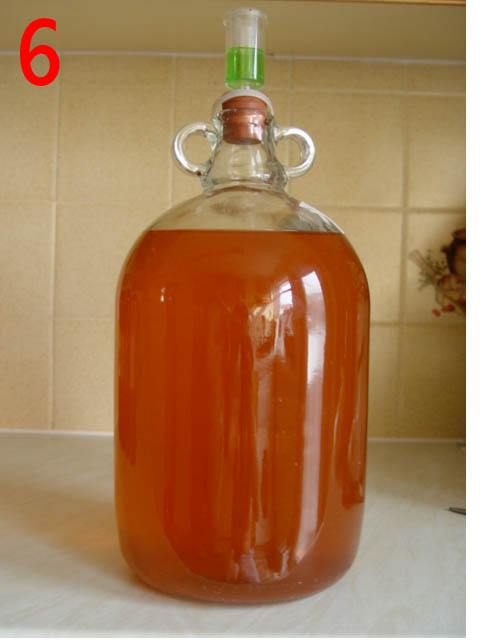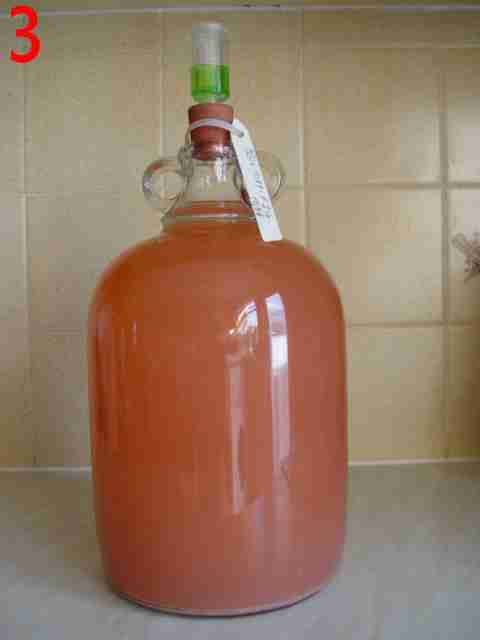Starting in May 2004 I intend adding to the recipes as I make the wine for 2004.
1045grams (2.5lbs) Rhubarb
1 Litre Pure White Grape Juice
100 Grams Sultanas
1 x 5ml tsp Pectic enzyme
** 1.kg Granulated Sugar
Yeast Starter,1x 5ml tsp general purpose wine yeast.
6.3kgs (14lbs) Rhubarb
5 Litres Pure white Grape Juice
500 grams Sultanas
1 table spoon Yeast nutrient
1 table spoon Pectic enzyme
** 5.Kgs Granulated Sugar
Yeast Starter, 1 x 5ml tsp general purpose wine yeast.
**Sugar Content.
With regard to the amount of sugar required this will depend on the amount of sugar in the rhubarb which is normally very small, and the Grape juice which can vary considerably in the degree of sweetness, we may therefore find that we have to add a small amount of sugar later. Remember we can add more sugar but cannot take it out!
Method
. Prepare Rhubarb, remove leaves, chop stalks in to 1 inch lengths, discard root end, wash in cold water do not soak. Do not use hot water as it releases the oxalic acid in the Rhubarb.
Place in open bucket, use only enough water to just cover the chopped stalks.
Sprinkle Pectic enzyme over stalks,
Crush 1 Campden tablet per gallon This is best done between two spoons, sprinkle powder over stalks.
Stir in ensuring all Rhubarb is still covered with water.
Cover bucket with suitable cloth, cotton, or calico, being ideal.
Leave for four days, after the first day the Rhubarb will be seen to start breaking up.
Assist this process by crushing with a masher or hands, twice a day, by the end of the forth day the Rhubarb will appear as a stringy mass and the juices will have been released into the water making it look pink in colour.
Place all the squeezed Rhubarb mash in the straining bag place into a clean container, a large saucepan is ideal, run approx one pints of cold water over the squeezed Rhubarb then knead thereby rinsing out any residual juice squeeze the straining bag as dry as possible, discard the now semi dry remains.
The mixture will now mainly consist of water and Rhubarb juice which now needs to be decanted into our barrel or demijohn, while doing this we can further filter off the remains of the Rhubarb by passing the juice through a colander, some pieces will still manage to get through with the juice but will do no harm they will fall to the bottom of the container towards the end of the fermentation, period and will then form part of the lees left in the container when we siphon off the fully fermented wine.
Now add the grape juice to the mixture.
Using a food processor where available chop the Sultanas mixing with a small amount of water, add to mixture
Dissolve the sugar adding a small amount of water, heat until completely clear, do not boil, melted sugar is extremely hot take great care when adding it to your juice not to splash yourself or other people.
Irrespective of what volume of wine you are making you should now have approximately 3/4 of the total volume.
Having thoroughly stirred your mixture take a two table spoons and place in a suitable container for adding to your yeast starter. Due to adding the hot sugar syrup the whole of the mixture should now be feel just warm, 18-22c 66-72F
At this point we need to take a reading on the hydrometer, to ensure that the reading is between 1085 -1090, if less than 1085, we need to add more sugar syrup when we bring the liquid up to our measuring mark. If higher than 1090, then we still have sufficient space to add plain luke warm water bringing us up to the measuring mark. Do not exceed the volume of mixture that you set out to make into wine, or the end product will be watery and have little taste. The adding of the final measure of liquid should have adjusted our S.G. to between 1085-1090.
For reference 2.25ozs of sugar will raise the S.G in one gallon of wine by 5 on the hydrometer scale, therefore to raise 5 gallons by five on the hydrometer we have to add 11.25ozs. To raise by 10, 22.5ozs and so on. Use a small amount of the wine mixture to dissolve any extra sugar needed, only heat enough to dissolve the sugar.
Do not go beyond 4.75 litre mark on your demijohn this will then still leave room in which your mixture can work. This is less important in large containers but do not exceed the 5 gallon, 22litre marker or the quality of your wine will be impaired.
Take one 5ml tsp of yeast and add it to a small quantity of warm water, stir until a smooth creamy mixture. The yeast starter needs to be kept warm,35c 90f is sufficient for the yeast to work. Cover with a clear polythene bag or cloth leave the yeast to mature, within 10 to 20 minutes it should be seen to start multiplying, when it can be seen that the yeast is working add the reserved sample of juice. Within 30-45 minutes the yeast should have started working on the combined mixture. When working vigorously on the whole of the yeast starter, which could take a couple of hours add to the bulk mixture. Within 12 hours the whole of the mixture should be seen to be working, a good indication is the chopped sultanas which will be forced to the top by the fermenting mixture.
Cover the container with a cloth, seal with a band or string so as to ensure fruit flies etc cannot access, I use an elasticised strap which allows me to pull the cloth taught across the top of the fermentation bucket thereby sealing the container.
Leave for 4 days, stirring gently 3 to 4 times a day if possible.
On the 5th day remove the cloth and band, fit the screw lid complete an airlock or decant into a container which will accommodate an airlock.
 Ensure that the airlock is partially filled with water, if correctly filled the bottom edge of the top will be below the water line of the airlock base. Some wine makers use a colour food die so that the level is easily seen. Either way an air tight seal must be maintained
Ensure that the airlock is partially filled with water, if correctly filled the bottom edge of the top will be below the water line of the airlock base. Some wine makers use a colour food die so that the level is easily seen. Either way an air tight seal must be maintained We are now into our six day since adding the yeast to the mixture the fermentation has already reduced the S.G. to 1014 this is despite the mixture being in an outbuilding with out any heat. We need now to keep a close eye on the levels taking the S.G. reading daily, we do not want the finished wine laying on the lees. As soon as the wine finishes we must decant it into a clean barrel or demijohns.<
Stuck Ferments If for some reason the yeast does not start to work on the mixture, start a fresh yeast starter, Dissolve 1 tsp of caster sugar if available, alternatively granulated sugar in water, cool until luke warm, hot water will kill the yeast. when cooled add 1 tsp yeast stir to a smooth mix and cover. When the yeast is active add 1 table spoonful of the juice mixture re-cover when the yeast has started working on that mixture add further but small quantities to the yeast, until you have say a 1/2 litre of mixture working working along with the yeast, add further quantities of the bulk mixture to the yeast until you have a litre or so working. This will take some time, to rush to yeast may deter it from working with the mixture. When your yeast mixture is working vigorously add up to 1/3 of the remaining mixture, when the yeast is working on that batch add the remaining 2/3, all of the wine mixture should now commence working. Make sure to keep the fermenting mixture at an even temperature at least until it is all working vigorously.
Today 13th May we have a S.G of 1010 and the airlock is still quite active. Saturday 15th of May. Our SG of our wine had dropped to 0988 on the hydrometer, allowing for the increase in temperature, call it 0990 The airlock has has now completely stopped bubbling. I have therefore added 1 crushed campden tablet per gallon and added one level tsp of fermentation stopper per gallon, effectively stopping the fermentation from going any further. Our alcoholic level being more than adequate for table wine. The alcoholic content of this wine is based on records. Started at SSG.1085/FSG 0990 using formula take FIG (Finish Specific Gravity) from SSG(Start Specific Gravity) divide the difference by 7.45 and the result is the approximate alcoholic content of this wine, being 12.75%.
I have decanted One gallon into a demijohn so that we can monitor the clearing process, The wine having finished fermenting has now been stopped, and passed through a strainer to remove the chopped currents and any remaining Rhubarb, it is now being left to clear, and has been placed in a cool part of the garage.
The Hydrometer is showing that all the sugar has been used up, on the basis of our records we know that the wine has been furnished with adequate sugar to give a sensible alcohol level, as is indicated above


1. May 15th. The finished result looks most unappetising at present but give it three or four days and it will start to look like rose wine, three or four months and it will be crystal clear and three or four years and it will be a mature fine wine, It pays to always look ahead whether driving your Mercedes 'A' Class or making wine for the future. The photo on the extreme right the same demijohn but on the
2. May 17th . It can be seen that the wine is starting to clear the yeast particles falling slowly to the bottom of the demijohn. 3. May 18th. Clearer still. 5. 3rd June Starting to look more like rose wine. The next stage will be to filter the wine, we will then see how it improves its clarity. 6. June 9th Our Wine left without the finings is still clearing as can be seen in the photographs 1 to 6 but still has a little way to go, it will be better for not having had the additives and will now stand until fully cleared before be bottled. If you do not want to put additives in your wine then you have to be patient and wait for the wine to clear and if you make enough it doesn't matter how long it takes, so long as it eventually reaches the standard of clarity you are looking for. 7.The finished article, no additives have been added to this demijohn to clear the wine although I have today 17th June taken the opportunity to re-filter the wine as I had the filtering system set up. I am now satisfied with the clarity of the wine and all that is left to do is to allow the wine to age, check for sweetness and then finally bottle. This wine from start to finish has taken 43 days, this has of course be helped by the spell of warm weather.
In addition to the demijohns that have been left to clear in their own time, I have cleared the wine in another of the same batch of five gallons by adding finings, in this case a product called "Quick Clear"
The colour of the wine in the glass will of course vary with each batch of wine. The Rhubarb used in this case was new season and the stalks were tender and bright red , hence the colour that has been imparted to the finished wine. If your wine does finish up paler than you would like then of course you can always add a bit of natural colouring like blackberry wine, or even blackcurrant, but add it slowly and check for the change in taste, make sure you don't spoil a good wine just to enhance the colour. To protect the colour in your wine from fading use green bottles, store in the dark or use brown demijohns.
1. Pressure Pump
2. Unfiltered Wine
3. Filter
4. Filtered wine
The normal way to filter wine is to use gravity to force the wine through the filter, however when filtering a lot of wine this can sometimes take and age, so a little help is required. I use a pressure pump in the form of a 1/2 gallon garden sprayer from which the sprayer portion has been removed, which I connect direct to an adapted demijohn bung, everything else it as it would be if you relied of gravity.
Warning Demijohns like wine bottles are not manufactured to withstand high pressure and therefore any increase must be small or the bottles and demijohns will explode, Sparkling wine and Champagne bottles are made in such a way as to withstand the pressures that those types of drink produce.
Our White Grape & Rhubarb is now finished cleared and bottled, alcohol level is approx 13% this was arrived at using the formula (SSGT minus FSG) Start Specific gravity minus the Finish Specific gravity, Result Divided by 7.45 will give us our 13% Our first impressions of the wine are that it has a mild smell of raspberries and early taste of the wine is that it is slightly acid but this will reduce as the wine matures. We are sure that it will be a very good wine and will make a nice aperitif, although both my wife and myself are agreed that like most Rosa wines it does need chilling before drinking. One demijohn does remain un-bottled as we are watching it clear naturally as distinct from using finings. At least that way we we will be assured of 6 bottles being kept back for future years.
The section is being continued as our wine progresses
Don't drink then drive